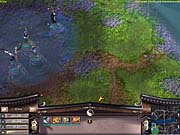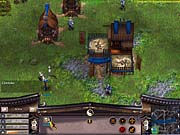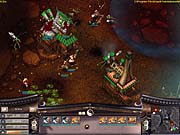Battle Realms Updated Preview
We take one last look at Battle Realms' graphics and special features.

Liquid Entertainment's Battle Realms is a game that greatly impressed the staff here at GameSpot when it was demoed at E3. The idea of real-time combat in an Asian-influenced gameworld suffused with magic looked to have the polish and style you'd expect from a design team composed of veterans of such gaming landmarks as Starcraft, Command & Conquer, and Red Alert. Previously on GameSpot, we've delved into the history of the gameworld, as well as presented an overview of the game system specifics on the four distinct clans that make up the game. Now, with the release of Battle Realms only a few weeks away, we had the chance to take a look at a late beta version and see how it is all coming together.

Battle Realms is set in a world that draws heavily on Asian mysticism for its sense of place. It also borrows liberally from Japanese anime and Hong Kong martial arts movies to create a look and feel that's never been seen in a PC real-time strategy game.
The game is clearly meant to make a graphical statement, and it succeeds. Its look is striking, with a palette of colors reminiscent of anime. The different game maps present a variety of environments, each with its own distinctive feel. Even the fog of war is done in a manner consistent with the setting: the fogging effect, when combined with the terrain art, is similar to the style used in many anime films and evokes the mist that often hangs in the valleys of the Japanese highlands.
Some of the special effects in the game are extremely well done. When your troops slog through water, the ripple effects created by their steps are simply stunning. The spell effects in combat are similarly impressive, and combat is enjoyable to watch simply for the sake of the special effects and unit animations.
The unit animations are far smoother than those previously seen in other games of this sort, and the idle animations are done in such a way as to create the illusion of units that really exist on the battlefield. For example, if you order a unit to train in a building of yours that is already occupied, he will queue up outside and sit on the ground and perhaps take off his hat to fan himself. Quite a few polygons are used to represent each unit, and the result is an impressive level of unit detail. This is possible because unlike in a game like Shogun (which takes place in a similar setting), you won't have huge armies of units to command.
When your armies grow large, you can rely on the fact that the individual units have a fairly developed AI. Simply select the units, click on an enemy town, and watch your troops attack buildings and units in an intelligent manner. The days of 10 swordsmen being distracted by a single farm in Warcraft II are long gone. Even while attacking a building, for example, your units will intelligently switch to other targets without your intervention if an enemy unit presents itself. Because of the speed with which combat takes place, micromanaging each battle at normal game speed will be impossible, especially with multiple battles taking place due to the nature of the maps.
Clan Units

The game is made up of four separate clans: Wolf Clan, Serpent Clan, Lotus Clan, and Dragon Clan. Each of these will have strikingly different units and capabilities--for example, the Lotus Clan emphasizes magic, and the Dragon Clan focuses on traditional combat. GameSpot has in-depth previews of each of the clans and their units and design direction, but a few items are worth emphasizing. While the basic elements of building your army are familiar, Battle Realms lets you direct the composition of your army even after you've built your units. For example, a peasant can be trained at different buildings and has the choice of becoming an archer, swordsman, or some other basic unit, depending on the specific clan involved. However, once he has been created in this manner, he can be turned into a special unit through additional training. When a Dragon Clan swordsman is trained in archery, he becomes a Dragon Warrior. This gives you not only the ability to further specialize your units after you build them, but also a choice of building a lot of basic units and attacking your enemies or taking the extra time to build a force of specials. Unit balance will be extremely important if this is to work right. The different clans will also have powerful hero units.

There are several features in the game that not only put a slightly new twist on real-time strategy gameplay, but also help to create the illusion of a persistent, coherent, and unified gameworld. For example, when buildings are damaged, they continue to burn even after the units that damaged them have stopped attack or been eliminated. This fire will eventually destroy the building unless it is put out with water. Peasant units can quench the flames, but only if they have access to a pond or lake. For this reason, building your towns near water is essential. Water is also necessary for irrigating your rice paddies, which provide food for your units. Hero powers extend to things like summoning rain to make rice paddies grow faster, which shows how closely the design team has linked all the elements of the game, from combat to production and supply.
The focus on gorgeous graphics and limited numbers of units in Battle Realms is reminiscent of the Myth series, although the force production and town-building elements obviously make it more of a traditional real-time strategy game than any of the Myth games were. Battle Realms clearly tries to incorporate the best elements of successful games in this genre, with multiple factions, special units, and heroes with unique powers, and its polished look does much to create a compelling environment.
Of course, in the end, Battle Realms could turn out to be stylish, attractive, and completely unremarkable in gameplay. Or the unit balance (always such a difficult thing to get right) could be skewed, especially with four clans of such varying capabilities. The beta we played seems to indicate that the game's basic framework is sound and that the true test will be in the deeper design issues that can be tested only through extensive play. The game is set for release the first week of November, and you can be sure we'll have a review for you right around that time.
Got a news tip or want to contact us directly? Email news@gamespot.com
Join the conversation